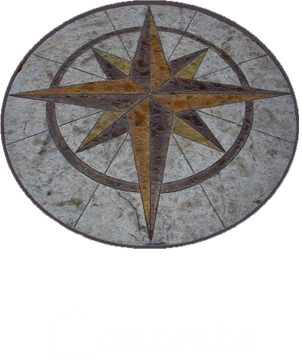Project Profile: Memphis Botanic Garden Memphis, Tenn.
Concrete Decor
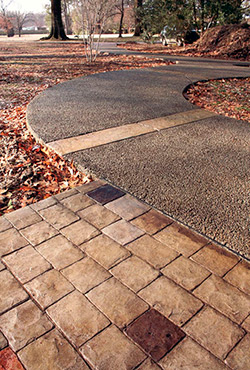
The project originally given Kevin Baltz, president of Memphis, Tenn., company Baltz & Sons Concrete Services, was a lot simpler than the one he ended up with. “I was first approached to do some hardscape and subbase for a network of brick or paver stone terraces,” he recalls. “The connecting walkways were going to be asphalt.” He can’t hide the disdain in his voice when he makes that last statement.
The project was a new herb garden, a pocket of about three-quarters of an acre graciously carved into the 96-acre Memphis Botanic Garden. The undertaking, which began to take shape late in 2010, was the latest of the Botanic Garden’s 23 specialty gardens located in the heart of the city and predicted to become the largest herb garden in the South.
“I convinced them that they could save money and flip the asphalt to pervious concrete,” he says. “I told them, ‘If you’re going to go to the trouble of pouring concrete anyway, you might as well make it work harder.’”
Beside the switch to pervious, Baltz pitched the idea of converting brick and stone construction plans to stamped concrete, which would have the same look but offer better ADA compliance. “Good photos were important. I had to show them that I knew what I was doing, and I had a nice portfolio. That really helped.”
So did a little numbers crunching. Baltz demonstrated with a calculator how he could handle the entire job — walkways, a footbridge over a slight natural swale, and multiple terraces — for about 60 percent of the hardscape budget set aside for the entire job. There’d be plenty of room in the budget to convert that dreaded asphalt walkway to pervious concrete.
Methodic madness
The job was a decorative concrete contractor’s dream. For this Baltz credits Jim Duncan, executive director of the Memphis Botanic Garden. “He came to trust me and to embrace new materials. I was pretty much given autonomy on this. He just stipulated that they didn’t want anything garish, and that’s about it.”
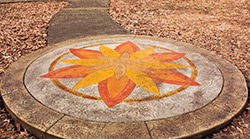 Baltz says he was able to achieve “eight different looks with one material.”
Baltz says he was able to achieve “eight different looks with one material.”
That was the advantage of stamped concrete. In addition to the pervious concrete, he was able to mimic the appearance of London cobblestone, Arizona flagstone, a European fan-design cobblestone, Southwest slate, fractured granite and timber — all at a fraction of the cost of the actual materials. (He also incorporated the Presidential Slate texture from Contractor Source’s Tru Impressions line into the design.)
One of Baltz’s concrete stamping sources was the Proline Concrete Color System from Proline Concrete Tools. He calls the Arizona Flagstone stamp from Proline “one of the most realistic stamps I’ve ever seen.” His Boardwalk Timber texture came from Tru Impressions. “They’re all beautiful stamps that perfectly fit our needs,” Baltz says. “I’ve seen people standing on the boardwalk and swearing it’s timber.”
The two cobblestone terraces required a dedication to what Baltz refers to as “methodic madness. It was like painting a 3,600-square-foot canvas.” The challenge was to create a mosaic of natural grays and earth tones subtly enhanced by 22 muted colors. “We started by undercoating each ‘stone’ beige, and then we individually went over each with a different topcoat. It took a lot of time and patience.”

Baltz’s most detailed work was in the compass rose design stamped into the presidential slate terrace. After pouring the textured mix, he used a GPS to align himself directionally and pressed in wrought iron scrollwork for ornamentation. He used rubber matte templates for directional letters and coated the surface with five or six different acid stains. He also used custom acrylic stains with powdered metallics and a sealer infused with metallics for a glittery finish.
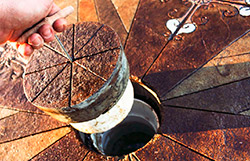 He credits the use of Buckeye UltraFiber 500 as a secondary reinforcement in the concrete for the visual appeal of his terraces and walkways. In addition to reducing shrink cracks, the cellulose supplement “pulled in the pigment. It takes colors in so well that it made a dramatic aesthetic difference,” he says.
He credits the use of Buckeye UltraFiber 500 as a secondary reinforcement in the concrete for the visual appeal of his terraces and walkways. In addition to reducing shrink cracks, the cellulose supplement “pulled in the pigment. It takes colors in so well that it made a dramatic aesthetic difference,” he says.
In the center of the compass rose stamp is a hidden vault. Guests at the Memphis Botanic Garden can follow clues hidden throughout the garden to find it.
Pervious was the greener choice
The connecting tissue between all of these various terraces is the pervious concrete walkway. The use of this material was critical since the paths would thread through tall old-growth trees. Pervious concrete was the greener choice, by far, over asphalt, which would have blocked proper drainage to the root system below. When water can’t get to roots, the roots go in search of water, buckling hard surfaces in the process.
That need for proper drainage also affected the stain choice. Baltz’s normal course of action on a walkway would have been to use an acid stain with a high-solid sealer, but that would have blocked water run-through. So he used a low-viscosity water-based stain from Tru Impressions that had such a high concentration of pigment that he didn’t have to use a sealer at all.
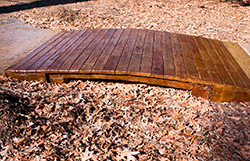 The pervious concrete solved another critical concern regarding the choice it replaced. Asphalt contains petroleum. “It’s a toxin in a garden area. Under the heat and humidity conditions of a city like Memphis, asphalt melts and leaks oil.”
The pervious concrete solved another critical concern regarding the choice it replaced. Asphalt contains petroleum. “It’s a toxin in a garden area. Under the heat and humidity conditions of a city like Memphis, asphalt melts and leaks oil.”
Furthermore, the pervious concrete provided a better-gripping surface, making it ADA-compliant and an aid to canes, walkers and wheelchairs.
What could be more natural for an herb garden walkway than the inclusion of herbs? It was the client’s idea to include the relevant thematic visual cue, so Baltz chose to run a periodic crossbands, stamped with actual herbs, across the width of the pervious concrete walkway.
“We knew that we were going to need to imprint herbs in the wet concrete long before we began to work, so we started collecting trimmings before winter,” he says. “We freeze-dried them to preserve them, but it also made the plants more rigid and easier to imprint with.”
It was a painstaking job to stamp real herbs into his creation, but well worth it.
The Memphis Botanic Garden’s Herb Garden is a welcoming patch of serenity that actually came in under budget — an added attraction in these challenging times.
